Small Orange Flowering Trees (With Pictures): Identification Guide
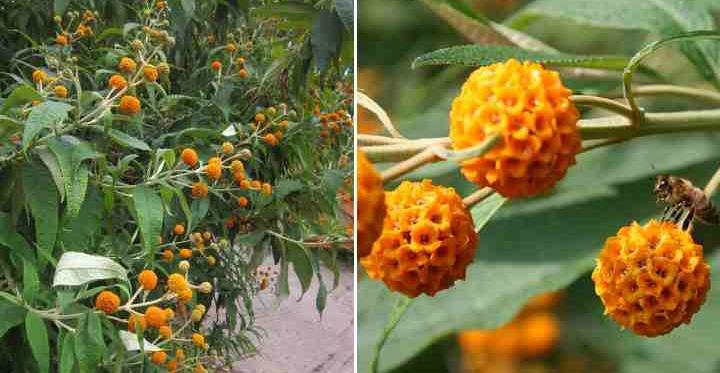
Small, orange-flowering trees can be a wonderful addition to your compact garden, enhancing its beauty with their orange blossoms. With their beautiful orange blossoms, these trees can transform into attractive centerpieces, adding an elegant touch to your outdoor environment.
If you’re looking for small trees with lovely orange flowers, consider the ornamental Japanese flowering quince. It produces attractive orange blossoms during its blooming season. The Chilean orange ball tree is another beautiful option, with large, spherical flower clusters. You might also consider the flame azalea, known for its beautiful display of showy, orange flowers with protruding stamens.
This article provides a helpful guide to small orange flowering trees, including images and essential gardening information.
Small Orange Flowering Trees (With Pictures): Identification Guide
Below, you’ll find a selection of the best small orange flowering trees suitable for planting in your garden:
Japanese Flowering Quince (Chaenomeles Japonica)
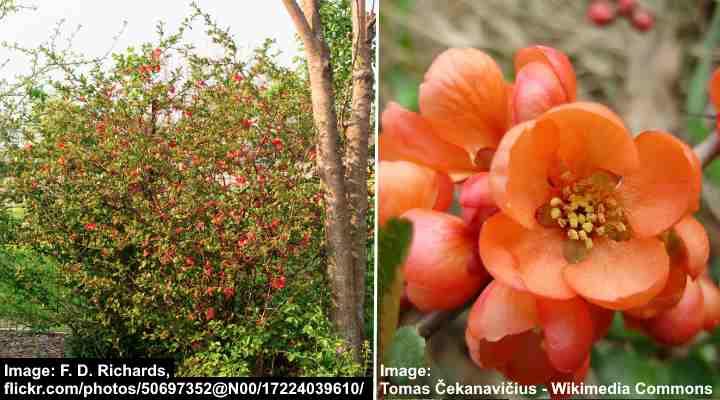
The Japanese flowering quince is a low-growing, deciduous small shrubby tree known for its beautiful, orange-colored flowers and spreading growth habit. Its bright flowers begin blooming in early spring, lasting for several weeks. After the blooming period, obovate, smooth leaves appear on bare branches, as well as small, apple-like fruits.
The Japanese flowering quince is highly versatile for landscaping, suitable as a garden border plant, a specimen plant, or for growing in containers. The shrub’s thorn-covered stems make it an excellent option for foundation plantings or as a security screen around a backyard.
Mature Size: 2 to 3 ft. (0.6 – 1 m) tall and 3 to 6 ft. (1 – 1.8 m) wide
USDA Hardiness Zones: 5 to 9
Sun: Full sun to partial sun
Orange Bottlebrush Tree (Callistemon ‘Tangerine Dream’)

The orange bottlebrush is a medium-sized shrub that can be shaped into a dwarf ornamental tree. The small flowering tree has bright orange flowers with greenish-yellow tips, closely resembling bottle brushes. Blooming primarily in spring, these distinctive flowers make occasional appearances throughout the year, attracting butterflies and hummingbirds.
The orange bottlebrush tree is popular for the bright orange colors it adds to gardens. Its bushy growth habit makes it a great option for creating informal hedges or evergreen screens. In addition, its ability to thrive in containers makes it an excellent plant for adding a pop of color to patios or decks.
Mature Size: 5 to 6.5 ft. (1.5 – 2 m) tall and 3 to 5 ft. (1 – 1.5 m) wide
USDA Hardiness Zones: 10 to 12
Sun: Full sun
Cudjoe Wood Tree (Bonellia macrocarpa)

The Cudjoe wood is a large shrub or small tree recognized for its beautiful, star-shaped orange flowers. The flowering tree thrives in hot weather, making it well-suited for sunny locations. The tree produces nectar-rich flowers and features a broad-spreading canopy. The canopy is covered with dense, lance-shaped evergreen leaves, measuring between 1.5 and 2.8 inches (4 – 7 cm) in length.
The Cudjoe wood tree is highly drought- and salt-tolerant, making it an excellent option for planting in coastal gardens. For best growth results, plant it in well-draining soil and full sun, although it can tolerate some shade. It blooms during spring and early summer, attracting bees and butterflies for pollination.
Mature Size: 6 to 15 ft. (1.8 – 4.5 m) tall
USDA Hardiness Zones: 10 and 11
Sun: Full sun
Chilean Orange Ball Tree (Buddleja globosa)

The Chilean orange ball is a beautiful, semi-deciduous shrub that can be shaped into a small tree. The tree is well-known for its bright orange, spherical-shaped flowerheads, which bring a pop of vibrant color to any landscape. The flowers bloom all summer and produce a sweet-smelling scent that attracts pollinators such as bees and butterflies.
Commonly known as the orange flowering butterfly bush, this tree displays elongated, slightly hairy lance-shaped leaves with a gray-green tint. Another identifying feature of this tree is its nicely rounded canopy. It has a compact growth habit, making it a great choice for adding some color to small front or backyards. Maintaining the size and shape of this dwarf tree is easy, thanks to its effortless trimming.
The Chilean orange ball tree is drought-tolerant and grows best in moist, well-draining soil. In addition, those living in rural areas may benefit from its natural resistance to deer.
Mature Size: 10 to 15 ft. (3 – 4.5 m) tall and wide
USDA Hardiness Zones: 7 to 10
Sun: Full sun
Flowering Maple ‘Victor Reiter’ (Abutilon ‘Victor Reiter’)
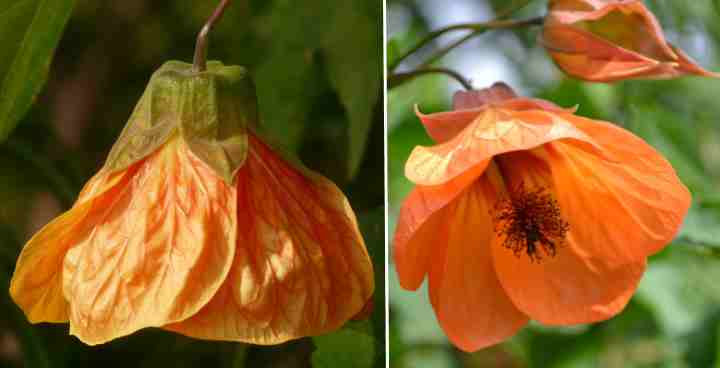
The ‘Victor Reiter’ flowering maple is a delightful evergreen shrub or small tree characterized by its bright-orange, bell-shaped flowers. The tree’s outward-facing, pendulous flowers resemble hibiscus blooms or colorful bells. The tree also has shiny, maple-shaped, dark green leaves, which contrast beautifully against the orange flowers.
The ‘Victor Reiter’ flowering maple thrives in full sun to partial shade in well-drained, moist soil that is rich in organic matter. With its beautiful orange blossoms, this tree is a great choice for adding a pop of color to small gardens. Grow this tree either in containers, as a specimen plant, or as a beautiful focal point.
Mature Size: 6 to 8 ft. (1.8 – 2.4 m) tall and 4 ft. (1.2 m) wide
USDA Hardiness Zones: 9 to 11
Sun: Full sun to partial shade
Geiger Tree (Cordia sebestena)
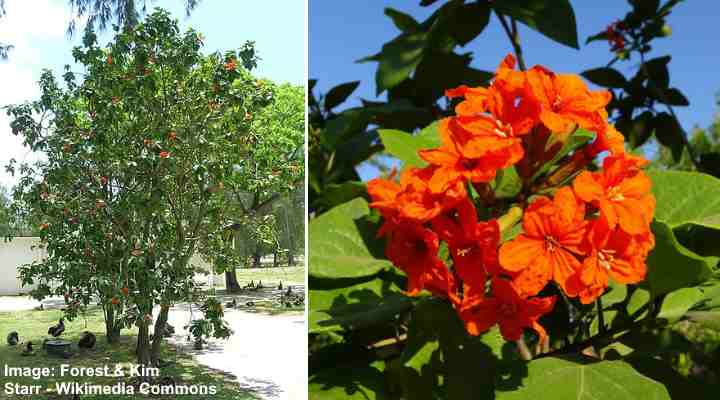
The small flowering Geiger tree is known for its beautiful vivid orange flowers and heart-shaped leaves. During the peak blooming season of the Geiger tree in summer and fall, it is covered with bell-like flowers in bright red-orange hues. However, the tree can also bloom year-round if the winter is mild. Several distinctive characteristics identify this tree, such as its uniquely shaped branches and white, oblong-shaped fruits.
The geiger tree is native to the state of Florida and thrives in tropical landscapes. With its modest height and compact form, it is an ideal tree for small gardens or to accompany larger trees.
In coastal regions, the geiger tree is an excellent choice for landscaping due to its brackish water tolerance, making it ideal for beach or seaside gardens. Additionally, it requires little maintenance and grows well in different soil types, including sandy or clay soils.
Mature Size: 10 to 30 ft. (4.5 – 7.6 m) tall and up to 15 ft. (4.5 m) wide
USDA Hardiness Zones: 10 and 11
Sun: Full sun, light shade, or dappled sunlight
Flame Azalea (Rhododendron calendulaceum)
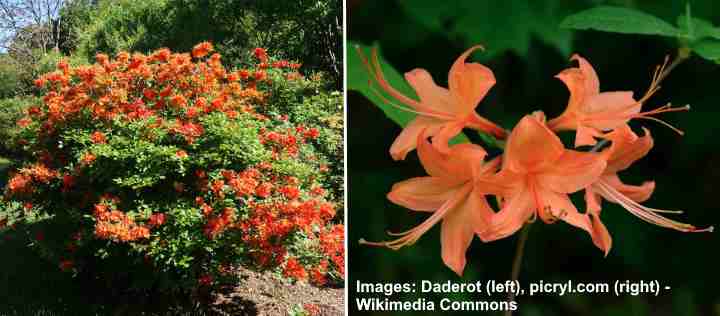
The flame azalea is a woody, deciduous shrub that can be grown as a miniature tree. This shrubby tree is popular for its beautiful display of showy, orange flowers with protruding stamens. The flowers bloom in late spring and summer, lasting for around 2 weeks. This tree’s name comes from the way its flowerheads resemble fiery candle flames.
In the fall, the flame azalea’s fuzzy, green leaves transition into a stunning yellow-orange color. The dwarf tree is incredibly versatile, making it a perfect choice for foundation planting, as a specimen plant, or for planting in groups to create a dramatic effect. Its bushy habit makes it a good choice for plating as mixed borders or serving as a privacy screen.
For the flame azalea to thrive, it is essential to plant it in acidic, well-drained soil and ensure it receives partial shade. If you want more blooms, trim away faded flowers, and they will reflower again in late summer.
Mature Size: 4 to 8 ft. (1.2 – 2.4 m) tall and wide
USDA Hardiness Zones: 5 to 8
Sun: Partial shade or full sun
Fragrant Orange Tea Olive (Osmanthus fragrans f. aurantiacus)

The fragrant orange tea olive is a medium-sized, evergreen shrub or small tree recognized for its apricot-scented, creamy-orange flowers. The flowers are small and tube-shaped, growing together in abundant clusters. The tree also has oval, dark-green leaves that beautifully contrast against the orange blooms.
The fragrant orange tea olive is an ideal choice for maintaining year-round greenery. With their bushy growth habit, they are great for creating privacy screens or evergreen hedges. You can also use them for foundation planting or as stand-alone focal points. Additionally, they work well for container planting to enhance the beauty of patios or entryways.
Mature Size: 10 to 15 ft. (3 – 4.5 m) tall and 6 to 8 ft. (1.8 – 2.4) wide
USDA Hardiness Zones: 7 to 10
Sun: Full sun to partial shade
Orange Bells (Tecoma alata)
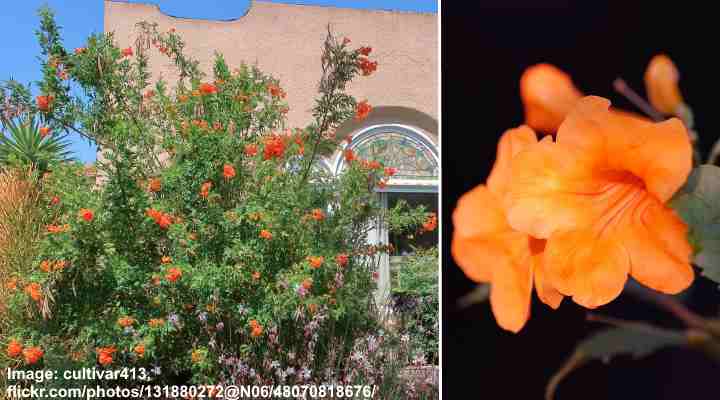
Orange bells is an attractive, evergreen shrub that can be pruned into a small tree. It is recognized for its attractive, trumpet-shaped orange flowers with flared petals. The blooming period for this orange flowering tree is from late spring until summer. The tree’s flowers are especially attractive to hummingbirds and butterflies, making it a favorite in wildlife gardens.
Another identifying feature of the orange bells tree is its ovate, dark green leaves, which have a slightly fuzzy and glossy texture. Featuring a delightful blend of contrasting orange and green hues, this plant becomes an excellent focal point in any garden. It can also be grown as an evergreen flowering hedge or incorporated into mixed borders.
The orange bells tree can grow in various soil types but prefers well-drained soil. This plant’s low-maintenance nature allows it to thrive even in challenging conditions, such as drought, heat, and salty air. This resilience makes it an ideal choice for semi-tropical coastal landscapes and arid environments.
Mature Size: 8 to 12 ft. (2.4 – 3.6 m) tall and wide
USDA Hardiness Zones: 8 to 11
Sun: Full sun to partial shade
Elder Tree (Tecoma Stans ‘Orange Jubilee’)

The elder tree is a fast-growing, shrubby tree recognized for its orange trumpet-shaped flowers and spreading habit. The tree’s large and eye-catching flowers bloom from spring to fall. Their delightful fragrance attracts pollinators such as bees and hummingbirds, making them perfect for wildlife gardens.
The elder tree has dark green, lance-shaped leaves with a glossy texture and jagged edges. This versatile tree can serve as a shade provider, hedge, privacy screen, or foundation plant. In addition, it can handle drought and loves full-day sunshine, making it perfect for hot and dry climates.
Mature Size: 10 to 20 ft. (2.4 – 3.6 m) tall and 8 to 12 ft. (2.4 – 3.6 m) wide
USDA Hardiness Zones: 9 to 11
Sun: Full sun
Related articles:
